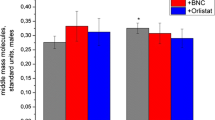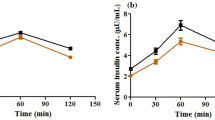Abstract
Metabolic syndrome is one of the major risk factors that lead to various serious complications like cardiovascular abnormalities, hyperlipidemia and diabetes. Its co-incidence with other organs dysfunction results in further deterioration of the condition or precipitation of other dysfunctions. This study aimed at studying the changes in the hepatic functions after the co-incidence of the high fat or fructose diets induced metabolic syndrome along with the gentamicin induced nephrotoxicity. Briefly, six groups of male Sprague Daley rats (n = 10–12) were fed with different feeding protocols; viz; standard rodent’s chow, an experimental high fat or high fructose diets feedings. For each, two groups were allocated that one of them was injected with normal saline and the other with 80 mg/kg/day I.P gentamicin during the last 24 days of the feeding period. The rats were monitored for changes in the metabolic data, glycemic control, lipid profile, renal and hepatic functions, oxidative stress and the inflammatory response. The study revealed stronger hepatic changes in the renal failure groups fed with the high fat diet rather than that in the groups fed with the high fructose diet. Although, the latter experienced a stronger deterioration in the glycemic control. The study suggests that the incidence of the hepatic changes is more linked to the incidence of the deterioration in the lipids profile that was observed after the high fat diet feeding. Overall, the co-incidence of the high fat diet induced metabolic syndrome along with the renal failure constitutes a risk factor for the hepatic dysfunction.






Similar content being viewed by others
References
Saklayen MG (2018) The global epidemic of the metabolic syndrome. Curr Hypertens Rep 20:12
Duseja A, Singh SP, Saraswat VA, Acharya SK, Chawla YK, Chowdhury S et al (2015) Non-alcoholic fatty liver disease and metabolic syndrome-position paper of the Indian national association for the study of the liver, endocrine society of India, Indian College of Cardiology and Indian Society of Gastroenterology. J Clin Exp Hepatol 5:51–68
Khosravi R, Ka K, Huang T, Khalili S, Nguyen BH, Nicolau B et al (2013) Tumor necrosis factor-α and interleukin-6: potential interorgan inflammatory mediators contributing to destructive periodontal disease in obesity or metabolic syndrome. Mediat Inflamm 2013:728987
Ibraheem ZO, Basir R, Aljobory AK, Ibrahim OE, Alsumaidaee A, Yam MF (2014) Impact of gentamicin coadministration along with high fructose feeding on progression of renal failure and metabolic syndrome in Sprague-Dawley rats. Biomed Res Int 2014:823879
Ibraheem ZO, Sattar MA, Abdullah NA, Rathore HA, Johns EJ (2012) Effect of high saturated free fatty acids feeding on progression of renal failure in rat model of experimental nephrotoxicity. Bosnian J Basic Med Sci 12:26–32
Kikugawa K, Kojima T, Yamaki S, Kosugi H (1992) Interpretation of the thiobarbituric acid reactivity of rat liver and brain homogenates in the presence of ferric ion and ethylenediaminetetraacetic acid. Anal Biochem 202:249–255
Rahman I, Kode A, Biswas SK (2006) Assay for quantitative determination of glutathione and glutathione disulfide levels using enzymatic recycling method. Nat Protoc 1:3159–3165
Gholamzadeh S, Zarenezhad M, Montazeri M, Zareikordshooli M, Sadeghi G, Malekpour A et al (2017) Statistical analysis of organ morphometric parameters and weights in South Iranian adult autopsies. Medicine 96:e6447
Constantino L, Paixao P, Moreira R, Portela MJ, Do Rosario VE, Iley J (1999) Metabolism of primaquine by liver homogenate fractions. Evidence for monoamine oxidase and cytochrome P450 involvement in the oxidative deamination of primaquine to carboxyprimaquine. Exp Toxicol Pathol 51:299–303
Chen HC, Farese RV (2002) Determination of adipocyte size by computer image analysis. J Lipid Res 43:986–989
Modlinska K, Stryjek R, Pisula W (2015) Food neophobia in wild and laboratory rats (multi-strain comparison). Behav Proc 113:41–50
Khitan Z, Kim DH (2013) Fructose: a key factor in the development of metabolic syndrome and hypertension. J Nutr Metab 2013:682673. https://doi.org/10.1155/2013/682673
Baena M, Sangüesa G, Dávalos A, Latasa M-J, Sala-Vila A, Sánchez RM et al (2016) Fructose, but not glucose, impairs insulin signaling in the three major insulin-sensitive tissues. Sci Rep 6:26149
Alicka M, Marycz K (2018) The effect of chronic inflammation and oxidative and endoplasmic reticulum stress in the course of metabolic syndrome and its therapy. Stem Cells Int 2018:4274361
Souza-Smith F, Braymer HD, Allerton T, Tzeng T, Harrison-Bernard L, Primeaux S (2015) Expression of inflammatory markers in visceral fat of obesity-prone rats is increased by high fat diet consumption. FASEB J 29:LB658. https://doi.org/10.1096/fasebj.29.1_supplement.lb658
Fontana L, Eagon JC, Trujillo ME, Scherer PE, Klein S (2007) Visceral fat adipokine secretion is associated with systemic inflammation in obese humans. Diabetes 56:1010–1013
Fessler MB, Rudel LL, Brown JM (2009) Toll-like receptor signaling links dietary fatty acids to the metabolic syndrome. Curr Opin Lipidol 20:379–385
Dekker MJ, Su Q, Baker C, Rutledge AC, Adeli K (2010) Fructose: a highly lipogenic nutrient implicated in insulin resistance, hepatic steatosis, and the metabolic syndrome. Am J Physiol Endocrinol Metab 299:E685–E694
Collins KH, Herzog W, MacDonald GZ, Reimer RA, Rios JL, Smith IC et al (2018) Obesity, metabolic syndrome, and musculoskeletal disease: common inflammatory pathways suggest a central role for loss of muscle integrity. Front Physiol 9:112
Osegbe I, Okpara H, Azinge E (2016) Relationship between serum leptin and insulin resistance among obese Nigerian women. Ann Afr Med 15:14–19
Gupta V, Singh AK, Gupta V, Kumar S, Srivastava N, Jafar T et al (2011) Association of circulating resistin with metabolic risk factors in Indian females having metabolic syndrome. Toxicol Int 18:168–172
Younossi ZM (2018) Nonalcoholic fatty liver disease and nonalcoholic steatohepatitis: implications for liver transplantation. Liver Transpl 24:166–170
Zaid O Ibraheem MZAS, Nor AA, Mohammed HA, Hassaan R, Edward JJ (2012) Effect of palm oil leaf extract eliais guinensis (standardized ethanolic fraction) on progression of experimental nephrotoxicity induced by gentamicin in sprague dawley rats. Int J Pharm Sci Rev Res 9:1–6
Ibraheem ZO, Munavvar AS, Nur AA, Mohammad HA, Hassaan AR, Tan YC et al (2011) The effect of acute experimental nephrotoxicity on the progression of metabolic and cardiovascular abnormalities in a rat model of saturated free fatty acid-induced metabolic syndrome. Adv Clin Exp Med 20:667–676
Abdel-Gayoum AA, Ali BH, Ghawarsha K, Bashir AA (1993) Plasma lipid profile in rats with gentamicin-induced nephrotoxicity. Hum Exp Toxicol 12:371–375
Li S, Tan H-Y, Wang N, Zhang Z-J, Lao L, Wong C-W et al (2015) The role of oxidative stress and antioxidants in liver diseases. Int J Mol Sci 16:26087–26124
Sharma U, Pal D, Prasad R (2014) Alkaline phosphatase: an overview. Indian J Clin Biochem 29:269–278
Todd JH, Hottendorf GH (1995) Renal brush border membrane vesicle aminoglycoside binding and nephrotoxicity. J Pharmacol Exp Ther 274:258–263
Kacew S (1989) Inhibition of gentamicin-induced nephrotoxicity by pyridoxal-5'-phosphate in the rat. J Pharmacol Exp Ther 248:360–366
Peng YF, Wang CF, Pan GG (2017) Relation of serum gamma-glutamyl transferase activity with copper in an adult population. Clin Chem Lab Med 55:1907–1911
Lushchak VI (2012) Glutathione homeostasis and functions: potential targets for medical interventions. J Amino Acids 2012:736837. https://doi.org/10.1155/2012/736837
Nyblom H, Berggren U, Balldin J, Olsson R (2004) High ast/alt ratio may indicate advanced alcoholic liver disease rather than heavy drinking. Alcohol Alcohol 39:336–339
Author information
Authors and Affiliations
Corresponding author
Ethics declarations
Conflict of interest
The authors have no conflict of interest to disclose.
Rights and permissions
About this article
Cite this article
Ibraheem, Z.O., Farhan, S.S., Al Sumaidaee, A. et al. Liver functions in combined models of the gentamicin induced nephrotoxicity and metabolic syndrome induced by high fat or fructose diets: a comparative study. Toxicol Res. 37, 221–235 (2021). https://doi.org/10.1007/s43188-020-00059-w
Received:
Revised:
Accepted:
Published:
Issue Date:
DOI: https://doi.org/10.1007/s43188-020-00059-w




